As two Midwesterners who moved to Puget Sound, we found out exactly how little we knew about seafood. After all, the fish we grew up on came out of lakes and streams.
Today fishing industries around the world – both fin fish and shellfish – are continuing to harvest as many fish as possible, mostly without regard to the remaining fish stocks, the environmental effects of fish farms, and the careful labeling and identification of the product in restaurants and markets.
And to make matters worse, we are facing the introduction of genetically engineered fish into the American food system.
Don’t tell fish stories where the people know you;
but particularly, don’t tell them where they know the fish.
Mark Twain
Clearly we’re being told fish tales – long fish tales!
Trusting souls that we are (and given the fact that we have little connection to the sources of our food), most people believe:
- Farmed fish are the same as wild fish.
- Genetically engineered fish are better than wild fish.
- The menu is always accurate: that when it says wild salmon, it really is wild.
Fish Farms ARE Feed Lots
Every fall, when kids go back to school, epidemics of lice skyrocket. It’s simply a case of more bodies in one place at one time; where the little critters can spread from one kid to another.
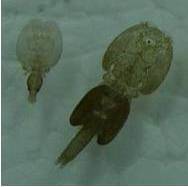
And every year when wild juvenile salmon migrate from freshwater lakes and rivers to the open ocean, the same phenomenon seems to occur when they come into fairly close range of farmed salmon. Sea lice are not at all related to the dry-land versions, but they can be just as aggravating. Unfortunately for the salmon, they can cause severe damage to both wild and farmed populations.
Dr. Alexandra Morton, a biologist for the Department of Fisheries and Oceans Canada (DFO), used DNA profiling to show that wild salmon dying en masse before spawning have a number of DNA “switched on” that healthy fish do not. And the wild salmon are dying from leukemia, retroviruses, brain tumors, and immune system decay. Are those sea lice spreading the virus?
Salmon leukemia virus raged through fish farms in the area in the early 1990s when the farms were first introduced. A retrovirus, salmon leukemia virus attacks the salmon’s immune system, so it dies of something else, much like the process of AIDS. At the time, it was discovered that virtually all the BC Chinook salmon farms were infected. They also discovered that the virus killed 100% of the wild sockeye salmon exposed to it. Yet nothing was done…
Instead, as soon as Dr. Morton traced the problem to fish farms, she became ostracized, and effectively put under gag order. When her findings were published in the distinguished journal Science in 2011, the DFO did not allow her to speak to the press, despite the fact that her findings were hailed as some of the most significant salmon research of the decade.
Learn more about Dr. Morton’s work here. Her research precedes two other apparently contradictory reports regarding salmon and sea lice – possible vectors for the transmission of salmon viruses.
The first, written by Gary Marty, UC-Davis and Sonja Saksida, University of Alaska, and published in the Proceedings of the National Academy of Sciences (PNAS), seems to show that salmon farming did not cause a crash in the population of wild pink salmon in the Broughton Archipelago of western Canada. Salmon farming produces nearly 1.5 million tons of fish annually and the sea lice were suspected to have migrated from the farms to infect wild populations. Marty’s conclusion:
The data from Broughton Archipelago pink salmon populations and sea lice experiments best fit the conclusion that the majority of pink salmon deaths are caused by something other than sea lice…
The second report, published in Aquaculture Environment Interactions, written by Martin Krosek , University of Washington, Seattle, and Andrew Bageman, University of Cambridge, concludes in the discussion section of the report:
The rapid growth of sea-cage salmon aquaculture in coastal seas has triggered the emergence of infestations of parasitic copepods (sea lice) that challenge aquaculture productivity. …(T)he exposure of wild juvenile salmon to lice during spring, and the productivity of local wild salmon populations, is likely dependent on the dynamics of outbreaks and control of louse populations on farms.
At just about the same time, researchers at the University of Victoria (Victoria BC) found:
Industrial-scale aquaculture production magnifies environmental degradation, according to the first global assessment of the effects of marine finfish aquaculture (e.g. salmon, cod, turbot and grouper). This is true even when farming operations implement the best current marine fish farming practices, according to the findings.
It is large-scale aquaculture – fish farming – that causes the most problems. While fish farming is an increasing source of protein for the world, much of the growth in aquaculture is in Asia where less attention is paid to the environmental effects and more to simply increasing production.
There has been much written about the health of feed-lot raised beef and, for the first time, research is proving that concentrated animal feeding operations (CAFOs) like fish farms are causing similar degradation of animal health in fish.
Farm fish are NOT the same as wild fish, and feedlot grain-fed cattle are NOT the same as pastured grass-fed cattle.
Genetically Engineered Fish
According to the Center for Food Safety, at least 35 species of fish are currently being genetically engineered around the world, including trout, catfish, tilapia, striped bass, flounder, and many species of salmon.

The purpose? To make them perfect candidates for CAFO-style fish farms. They are “designed” to grow faster with larger muscles, resist diseases, and tolerate higher temperatures. The genes being introduced into these fish come not only from other fish, but also from coral, mice, bacteria, and even humans.
Actually, we should be clearer on the purpose. It’s not just to make the fish more “farm suitable,” it’s to make more money for the people growing and marketing GE fish – the factory fish farmers. And, of course, the companies holding the patents on the technology.
How does all this work? AquaBounty Technologies, the Boston-based company seeking approval of a genetically engineered salmon, inserts DNA from another salmon species and the eel pout into the genome of an Atlantic salmon. The new genes make the salmon produce growth hormone all the time instead of just for three months each year as they normally would. The result? They grow to market size in just over half the time it takes for Atlantic salmon, 16/18 months instead of 30.
The eggs will be produced in the tiny province of Prince Edward Island, Canada, and shipped to an inland facility in Panama where they will be grown, harvested, and processed.
More than 2,500 grocery stores are refusing to sell GE seafood should it come to market and 260 chefs across the country have signed on to a letter by Chefs Collaborative objecting to the transgenic fish.
We are just weeks away from FDA approval of genetically engineered salmon and nearly 1.5 million objections have been filed. Now we will just have to wait and see whether the FDA will approve.
What’s On the Menu?
When you look down at your plate, it’s pretty easy to tell the peas from the corn, and the squash from the potatoes. Well, mashed sweet potatoes and mashed acorn squash DO look a lot alike. On the other hand, not many people have trouble telling chicken from beef when it has been cooked and served.
However, we’re not in the habit of trying to tell which kind of fish is on our plate. There are so many different kinds and so many look alike, that we have to accept that the label or menu listing has got it right.
Turns out our trust has been abused and Oceana, an international organization working to protect the world’s oceans, has been tracking labeling fraud in supermarkets and restaurants. Oceana released a report titled “Bait and Switch: How Seafood Fraud Hurts Our Oceans, Our Wallets, and Our Health.”
Recent studies have found that seafood may be mislabeled as often as 25% to 70% of the time for fish like red snapper, wild salmon, and Atlantic cod, disguising species that are less desirable, cheaper, or more readily available.
There are more than 1,700 different species of seafood from all over the world now available for sale in the US. Could you tell what kind of fish is on your plate?

Most often cheap fish is substituted for more expensive species, more plentiful fish for over-fished species., or farmed fish for wild. Because wild salmon sells for so much more than farmed salmon, many are tempted to sell farmed salmon as “wild-caught” as often as 56% of the time, as found in a study by Consumer Reports.
New DNA barcoding technology makes it possible to actually barcode each fish based on the gene sequences in the flesh. Handling processes for large volumes of fish make it impossible to tag each individual fish, but this method makes it possible to police the fish in the seafood system.
Which Fish Would You Rather Eat?
We are just beginning to understand that we may soon reach the end of the line – pun intended – for some of our “keystone” fish species: salmon, sea bass, cod, and tuna. Authors Paul Greenberg (Four Fish) and Daniel Pauly (Five Easy Pieces) have written excellent books telling us how – and why – we will be out of fish by the middle of the century unless we take some drastic steps.
Top chefs in the US and Europe are pushing for sustainable seafood; sustainable sushi bars are popping up in cities across the country; and food service giants like Bon Appétit Management Company and Sodexo are offering sustainable seafood.
But how is a discerning consumer going to find good quality, sustainable fish to purchase for his or her own table?
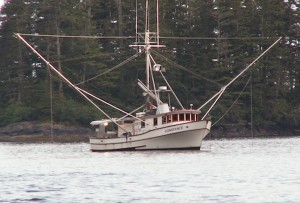
Even perfect fish don’t easily get from boat to table. Fishermen like Krist Martinsen, captain of the Fishing Vessel Constance, Sitka Alaska, take special care to treat the fish they catch respectfully and prepare them carefully.
Martinsen and his sons, Olin and Karl, are troll fishermen and fish with hooks and lines, using natural and artificial baits. They bring each fish in by hand.
When a fish is caught in a gill net or a seine it goes into stress as it starts to suffocate. That stress causes the fish to build up lactic acid in its muscles, just like humans do under stress. (Watch the video below to see how purse seined salmon are netted and moved to the hold of the boat by vacuum suction through giant tubes.)
The F/V Constance travels at 2-3 knots, the same speed that the fish are moving in the water. When the fish bites, the line is brought to the back of the boat slowly.
The fish is moved to the side of the boat and stunned to prevent it from flopping on the deck and bruising. Then a cut is made through the gills to drain the blood, the head is cut off, and the fish is eviscerated. In a time-consuming step, all remaining blood is removed under pressure. To ensure that no degradation takes place once its frozen, each fish must be bloodless when is placed in the freezer.
(To see exactly how this is done, watch this video. Warning: It’s not for the squeamish.)
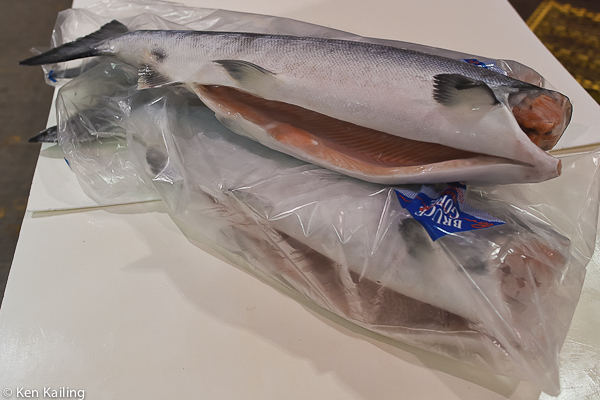
The final preparation for freezing requires that each fish be carefully arranged in the freezer with the belly open and the tail spread completely flat. Once frozen, the fish are dipped in salt water to create a glaze that prevents air from reaching the meat.
On deck – or below – each boat has a “super freezer” that rapidly drops the core temperature of the fish down to -30 degrees. Fish are prepared so fast that they are frozen “pre-rigor” and actually go through rigor mortis after they are thawed.
Mark Tupper, Triad Fisheries, offers these premium-priced specialty fish, considered sashimi-grade salmon, to customers around the world under the Bruce Gore Frozen-at-Sea brand.
About one-third of the fish goes to Europe, to distributors or wholesalers that sell to retailers and restaurants or to processors who are smoking the fish or making other products.
Another third goes to Japan; much of it to the Tsukiji Market which is a wholesale fish market in Tokyo where an old, established Japanese family sells to high-end retailers in the Tokyo area and to top-tier sushi restaurants.
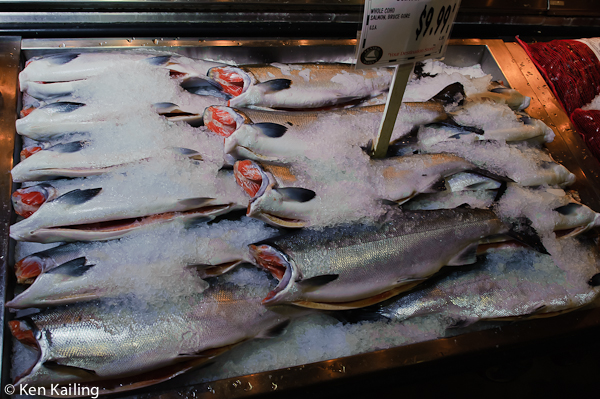
Puget Sound’s Town and Country Markets, which include three Central Markets, Greenwood Market, Ballard Market, and Bainbridge Island Town and Country Market, offer Bruce Gore Frozen-at-Sea salmon in their fish departments.
We are just beginning to understand that we may soon reach the end of key fish stocks of the large predator fish – salmon, sea bass, cod and tuna – that we all love to eat. Unfortunately most consumers have no idea how the fish they eat really gets to the table.
The majority of fish available in conventional supermarkets – and on ice in some of the best natural food markets and co-ops – has been caught conventionally: by trawling, gillnetting, or purse seining. Net fishermen seek to catch as many fish as possible, as quickly as possible, and handle them as little as possible.
Contrast that to the careful and respectful handling Krist Martinsen and the captains of the other fishing vessels represented by Triad Fisheries give to the fish they catch.
Know where your fish comes from; ask your fish monger:
- Is this fish sustainably harvested?
- Do you know where this fish was caught?
- Do you know how this fish was caught?
- Do you know how this fish was handled after being caught?
- Is this fish “fresh” or “frozen at sea?”
Would you rather eat a salmon caught this way…
… or this way?
It’s clear that as consumers we have to take responsibility for the food we eat. We also need to influence (pressure?) the retail and restaurant buyers from whom we get our food so we get the very best available.
We have come to believe that:
- Farmed fish are NOT the same as wild fish.
- Genetically engineered fish are NOT better than wild fish.
- The menu is most often NOT accurate when the label reads wild salmon.
Know where your fish come from: know your fishmonger, know your chef, and know your sources.
What’s Next?
The issues surrounding production, processing, and marketing of authentic, thoughtfully harvested, healthy seafood are many and complex. We will be addressing the topic of “good fish” throughout the coming summer.
Keep reading as we explore the business of fish. We will talk to fishermen (and women), get inside fish processing operations, and follow the regulation (or not) of genetically engineered salmon.
It’s a tough business! Let’s be careful out there!
________________________________________
Additional Reading:
Washington Post: Oceana launches seafood fraud campaign
New York Times: Tests Reveal Mislabeling of Fish
Trade Secrets: Renaming and Mislabeling of Seafood (PDF)
The salmon scam: ‘wild’ often isn’t. (Consumer Reports. 2006. Retrieved May 31, 2011 from accessmylibrary: http://www.accessmylibrary.com/coms2/summary_0286-22937486_ITM)
(Large-Scale Fish Farm Production Offsets Environmental Gains, Assessment Finds, Science Daily. To learn more, download the Global Aquaculture Performance Index (GAPI) report here.)
GoodFood World Articles:
Guess What Kind of Fish You’re Eating?
Farmed Salmon and Sea Lice: What’s Killing Wild Pink Salmon?
Large-Scale Fish Farming Degrades the Environment
A Tale of Two Fish: Which Fish Would You Rather Eat?
More Resources:
Center for Food Safety, GE Fish
Salmon Confidential
Organic Consumers Association

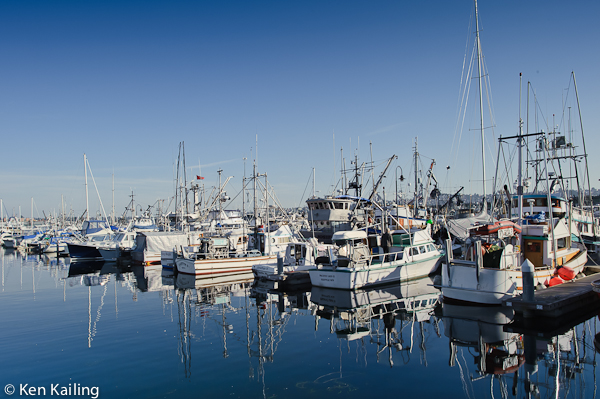
Sadly, promoting one type of gear and disparaging other fisheries serves little purpose. Salmon are harvested in different regions with a variety of methods depending on whether they eat small fish so will bite on bait or lures which makes using hooks necessary or whether they graze oceans feeding on plankton and small crustaceans. These species that eat low on the food chain, like sockeye, humpies and chums are generally caught with nets and the quality of these fish can be as fabulous as troll caught salmon. The prized Copper River chinook and sockeye are gillnet caught fish. The abundant Bristol Bay sockeye run of 25 million and 65 million fish returning in a month are entirely harvested by gillnets. These small family fishing businesses provide consumers with sustainably harvested seafoods. At the same time NOAA is promoting marine feedlots, even in Washington’s waters. Using a NOAA photo that shows an old chunk of wild salmon next to a farmed salmon that is intact clearly shows the agency’s bias. Frozen wild salmon is as beautiful and fine tasting as when it comes from the ocean and is put into chilled refrigeration onboard the fishing boat. Consumers can be confident of the fine quality of wild salmon taken from the freezer case, as well as during the peak of the harvest season when it is fresh in the marketplace.
“Dr. Alexandra Morton, a biologist for the Department of Fisheries and Oceans Canada DFO”
I feel obligated to point out only the largest fib in this article.
Morton works full time demonizing the DFO. Calling her a DFO scientist couldn’t be further from the truth.
Let us all save the wild fish by eating them.